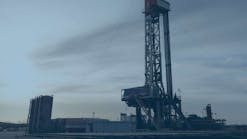Start-up of production is imminent from the supergiant Marlim field complex in Brazil's offshore Campos basin.
A two well prepilot, installed last year, in weeks to come will begin producing 10,000 b/d of crude from Marlim, Brazil's biggest discovery.
Early development of Marlim had been a casualty of budget cuts by state oil company Petroleos Brasileiro SA, but the Middle East crisis spurred the government last fall to accelerate Brazilian exploration and development, putting Marlim back on the front burner.
Petrobras has submitted to the government a 5 year, $16.9 billion plan to boost Brazilian crude production to 1 million b/d by 1995 from the current 660,000 b/d (OGJ, Sept. 10, 1990, p. 21). Brazil's two Campos basin supergiants, Marlim and Albacora, will be expected to account for the biggest share of that increase.
A later Marlim pilot project could be producing as much as 50,000 b/d by January 1992. Ultimately, Marlim could produce 300,000-350,000 b/d at the turn of the century.
Petrobras put a pilot on stream in Albacora field in October 1987. It currently produces about 18,000 b/d of oil and 8.8 MMcfd of gas. Ultimately, Albacora could produce 200,000-250,000 b/d of oil by the late 1990s.
MARLIM BACKGROUND
Petrobras discovered Marlim field, the biggest structure in the Marlim complex, in February 1985 with the 1FJS-219 wildcat drilled in 2,746 ft of water.
Marlim covers an area of 152 sq km, with original oil in place (OOIP) estimated at 8.2 billion bbl and original gas in place at 3.53 tcf. Recoverable reserves are pegged at about 1.75 billion bbl.
The entire Marlim turbidite fan complex covers 381 sq km and includes oil accumulations in water depths of 1,312-5,905 ft. Petrobras geologists estimate the complex's total OOIP at 14 billion bbl, or about 32% of Brazil's total OOIP.
Petrobras used 3D seismic data to determine step-out locations 4-RJS-377, 4-RJS382, 1-RJS-359, 4-RJS-381, and 4-RJS-403 to tap other key structures in the complex (see map, OGJ, Sept. 10, 1990, p. 23).
All Marlim structures produce from Oligocene Carapebus sandstone. Oil gravities are 18-20.
MARLIM PREPILOT
The 1 year, $10 million Marlim prepilot will gather reservoir performance data. Petrobras last October installed the first of two monobuoys in 1,312 ft of water and the second of a new generation of guidelineless, deepwater, wet Christmas trees in 2,365 ft of water to support the prepilot.
The monobuoys, said to be the world's largest at 16.4 ft tall and 49.2 ft in diameter, were designed by Setal Lummus Engenharia e Construcoes. Each can accommodate two 120,000 dwt vessels.
The prepilot will set world water depth records for production and installation of a monobuoy.
Petrobras installed the first of the new design Christmas trees in the Campos basin's Marimba field early in 1990 (OGJ, Feb. 12, 1990, p. 20). They weigh 53 tons and stand about 38 ft tall. CBV-Industria Mecanica SA, Rio de Janeiro, is supplying Petrobras 10 such deepwater wet Christmas trees under a $15 million contract.
MARLIM PILOT
Marlin's prepilot will be followed by an eight well pilot tied into the prepilot that will gather reservoir and operating data for 4 years prior to installation of full field development facilities.
The pilot will entail installation of the Petrobras XX semisubmersible production platform, formerly the Fortuna Ugland flotel, in 1,925 ft of water in Marlim field. Pilot production is expected to peak at 52,000 b/d of oil and 21.9 MMcfd of gas in 1993.
Produced oil will move through two 8 in. flexible lines to a catenary anchor leg mooring system installed in 1,312 ft of water that can handle shuttle tankers of as much as 115,000 dwt. Gas will move through an 8 in. combined flexible-rigid line to the Albacora-Garoupa trunkline and then to shore.
MARLIM FIRST PHASE
First phase full development of Marlim will involve waterflooding and installation of Petrobras XVIII and XIX semisubmersible production platforms in the southeast portion of the complex in water depths of 2,985 ft and 3,215 ft, respectively.
Phase 1 production will start in 1994 and peak from 52 subsea completions at about 200,000 b/d and 81 MMcfd of gas in 1996.
Each of the GVA 4500 stationary production units (SPUs) will be able to process 100,000 b/d of crude and 148 MMcfd of gas and inject about 126,000 b/d of water.
No oil-water or gas-oil contacts were encountered in the six discovery or delineation wells.
MARLIM PHASE 2
Phase 2 development of the Marlim complex will entail installation of another five SPUs beginning in 1997 and ending in 2003.
The second phase calls for 77 production wells-including six from the pilot, 14 water injectors, and 2 gas injection wells.
Second phase oil production will move through a 12 in. line and gas through 8 or 10 in. lines to a central facilities support platform.
This platform will be installed in 656 ft of water. From there, total field production will move to shore at a peak rate of as much as 352,000 b/d and 152 MMcfd of gas by 2003.
Marlim's pipeline infrastructure will involve 340 km of flexible gathering lines and 280 km of rigid transport lines.
MARLIM ECONOMICS
Joao Carlos Franca de Luca, Petrobras exploration/production director, cited Marlim as the company's most important project during the next 5 years.
Total spending for initial Marlim development through 1996 is projected at about $1.84 billion. That includes construction of the first two semisubmersible platforms at a cost of $500 million.
The Japanese trading company Nissho-Iwai is expected to help with financing construction of the two SPUS. The Tenenge/Fels combine won bids for building the two SPUs at a Singapore shipyard. Petrobras projects cumulative Marlim production after 25 years at 712 million bbl of oil and 303 bcf of gas.
De Luca contends the project will be economic with net income of about $3 billion and annual internal rate of return of 53%. The payout is expected within 2 years and 5 months of start of production.
De Luca also pointed to relatively low lifting costs at Marlim of $7.40/bbl of oil equivalent (BOE), compared with an average cost of $1314/BOE for the Campos basin. Minimum Marlim flow is about 5,000 b/d/well.
ALBACORA BACKGROUND
Albacora, the Campos basin's other supergiant field, lies almost 100 km offshore in water depths of 656-6,234 ft.
The field was discovered in September 1984 with the 1RJS-297 wildcat, drilled in 961 ft of water.
Petrobras estimates Albacora OOIP at 4.4 billion bbl and recoverable reserves at almost 1 billion bbl.
Albacora production started in October 1987 with a 22 well pilot that includes 16 exploratory and delineation wells. Albacora produces from seven sandstone reservoirs: Cretaceous/Albian Namorado, Oligocene 1, Oligocene 2, Oligocene 3, Oligo-Miocene, and Miocene.
ALBACORA PRODUCTION
The first phase of Albacora development involved a six well pilot in 827-1,375 ft of water.
The pilot phase is being expanded by eight wells. A converted tanker serves as a floating production processing unit to gather oil via monobuoy.
Albacora associated gas moves to the central platform in Garoupa field via 16 in., 48 km line. Expanded pilot flow is expected to reach 33,000 b/d and 15 MMcfd.
If cash is available, a second phase of Albacora production could go on stream in 1994. That would bring peak production to 200,000 b/d and 106 MMcfd of gas in 1996.
Petrobras would implement the third phase of Albacora development with 61 wells in water depths as great as 5,134 ft. That would entail another 130,000 b/d by 2000, with start-up in 1998.
Petrobras is studying several alternatives for Phase 3 development, including semisubmersible tension leg platforms and subsea multiphase pumping systems in tandem with a platform installed in 656 ft of water.
Copyright 1991 Oil & Gas Journal. All Rights Reserved.

